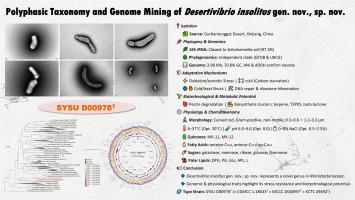Polyphasic taxonomy and genome mining of Desertivibrio insolitus gen. nov., sp. nov., a novel psychrotolerant pectin-degrading actinobacterium isolated from desert soil
IF 5.8
Q1 MICROBIOLOGY
引用次数: 0
Abstract
Extreme arid environments harbor diverse yet underexplored microorganisms with unique ecological adaptations and significant biotechnological potential. Here, we characterized a novel actinobacterium, strain SYSU D00978T, isolated from desert soil in the Gurbantunggut Desert, Xinjiang, China. The strain was Gram-stain-positive, aerobic, curved-rod-shaped, non-motile, catalase-positive, and oxidase-negative. Phylogenetic analysis based on the 16S rRNA gene placed it within the family Microbacteriaceae, showing highest similarity to Schumannella soli 10F1D-1T (97.3 % sequence identity) and Schumannella luteola KHIAT (97.2 %), while phylogenomic analyses consistently supported its distinction from known genera. The genome of SYSU D00978T was 2.98 Mb with a G + C content of 70.8 %. Comparative genomic analysis showed that its average nucleotide identity (ANI) and digital DNA–DNA hybridization (dDDH) values against the closest related taxa were below the species delineation thresholds (ANI: 95–96 %; dDDH: 70 %). The strain exhibited psychrotolerance and pectin-degrading activity, indicating ecological adaptation to cold periods and involvement in organic matter turnover in desert soils. Functional annotation identified genes linked to oxidative and osmotic stress responses, carbon starvation, cold and heat shock, DNA repair, and ribosome hibernation, reflecting resilience to extreme conditions. Additionally, biosynthetic gene clusters for terpene, type III polyketide synthase, and beta-lactone suggested potential for novel bioactive compounds. Phenotypic and chemotaxonomic traits further supported its taxonomic novelty. Based on polyphasic evidence, strain SYSU D00978T (= CGMCC 1.18633T = MCCC 1K04997T = KCTC 49492T) represents a novel species of a new genus within the family Microbacteriaceae, for which the name Desertivibrio insolitus gen. nov., sp. nov. is proposed. This study expands our understanding of microbial diversity and ecological adaptations in extreme desert environments and provides a valuable resource for future biotechnological exploration.

荒漠土壤中耐寒果胶降解放线菌荒漠弧菌的多相分类与基因组挖掘
极端干旱环境孕育着多种多样但尚未开发的微生物,它们具有独特的生态适应性和巨大的生物技术潜力。本文研究了从新疆古尔班通古特沙漠土壤中分离到的一种新型放线菌SYSU D00978T。革兰氏染色阳性,好氧,弯曲棒状,无运动,过氧化氢酶阳性,氧化酶阴性。基于16S rRNA基因的系统发育分析将其定位于微细菌科,与soli Schumannella 10F1D-1T(97.3%序列同源性)和Schumannella luteola KHIAT(97.2%序列同源性)相似性最高,而系统发育分析一致支持其与已知属的区别。SYSU D00978T的基因组为2.98 Mb, G + C含量为70.8%。比较基因组分析表明,其与近缘类群的平均核苷酸同一性(ANI)和数字DNA-DNA杂交(dDDH)值均低于物种划分阈值(ANI: 95 - 96%;dDDH: 70%)。该菌株表现出耐寒性和果胶降解活性,表明其对寒冷期的生态适应和参与了荒漠土壤的有机质转化。功能注释鉴定了与氧化和渗透应激反应、碳饥饿、冷休克和热休克、DNA修复和核糖体冬眠相关的基因,反映了对极端条件的适应能力。此外,萜烯、III型聚酮合成酶和β -内酯的生物合成基因簇表明了新型生物活性化合物的潜力。表型和化学分类性状进一步支持其分类新颖性。根据多相证据,菌株SYSU D00978T (= CGMCC 1.18633T = MCCC 1K04997T = KCTC 49492T)代表了微生物科新属的一个新种,建议将其命名为Desertivibrio solitus gen. nov., sp. nov.。该研究扩大了我们对极端沙漠环境中微生物多样性和生态适应性的认识,为未来的生物技术探索提供了宝贵的资源。
本文章由计算机程序翻译,如有差异,请以英文原文为准。
求助全文
约1分钟内获得全文
求助全文
来源期刊

Current Research in Microbial Sciences
Immunology and Microbiology-Immunology and Microbiology (miscellaneous)
CiteScore
7.90
自引率
0.00%
发文量
81
审稿时长
66 days
 求助内容:
求助内容: 应助结果提醒方式:
应助结果提醒方式:


